Global Perspective social Determination PDF
VerifiedAdded on 2021/06/18
|16
|4563
|37
AI Summary
Contribute Materials
Your contribution can guide someone’s learning journey. Share your
documents today.
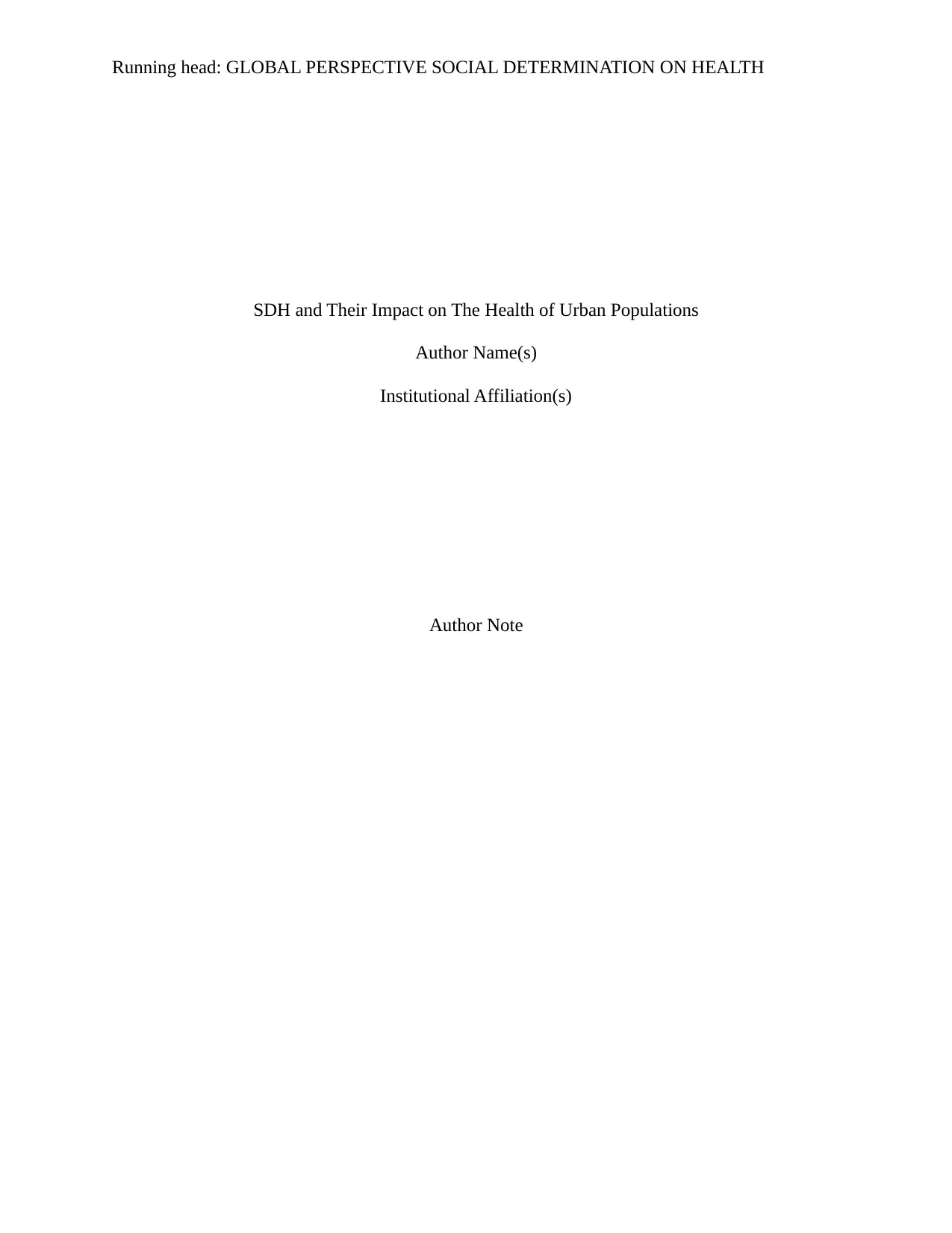
Running head: GLOBAL PERSPECTIVE SOCIAL DETERMINATION ON HEALTH
SDH and Their Impact on The Health of Urban Populations
Author Name(s)
Institutional Affiliation(s)
Author Note
SDH and Their Impact on The Health of Urban Populations
Author Name(s)
Institutional Affiliation(s)
Author Note
Secure Best Marks with AI Grader
Need help grading? Try our AI Grader for instant feedback on your assignments.
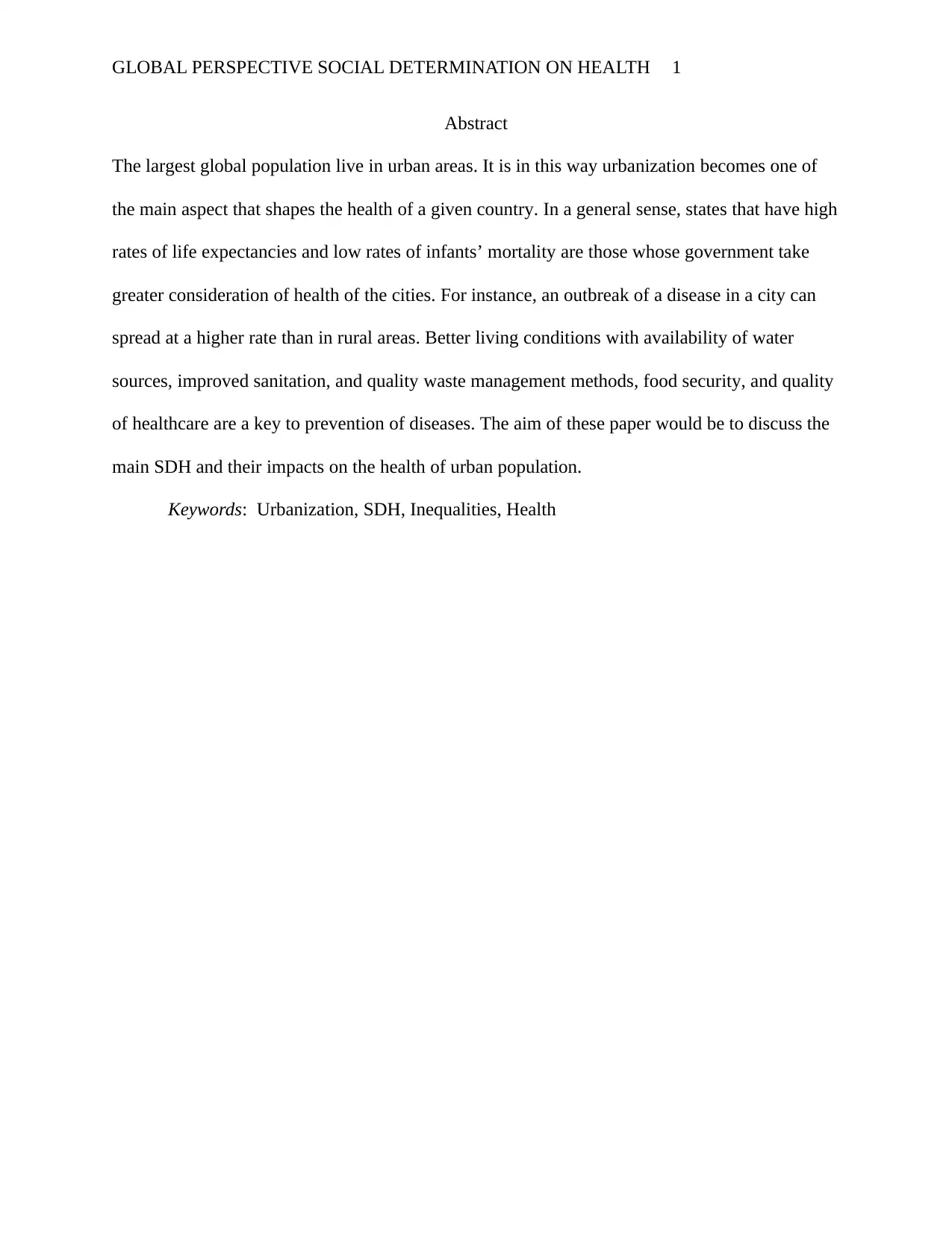
GLOBAL PERSPECTIVE SOCIAL DETERMINATION ON HEALTH 1
Abstract
The largest global population live in urban areas. It is in this way urbanization becomes one of
the main aspect that shapes the health of a given country. In a general sense, states that have high
rates of life expectancies and low rates of infants’ mortality are those whose government take
greater consideration of health of the cities. For instance, an outbreak of a disease in a city can
spread at a higher rate than in rural areas. Better living conditions with availability of water
sources, improved sanitation, and quality waste management methods, food security, and quality
of healthcare are a key to prevention of diseases. The aim of these paper would be to discuss the
main SDH and their impacts on the health of urban population.
Keywords: Urbanization, SDH, Inequalities, Health
Abstract
The largest global population live in urban areas. It is in this way urbanization becomes one of
the main aspect that shapes the health of a given country. In a general sense, states that have high
rates of life expectancies and low rates of infants’ mortality are those whose government take
greater consideration of health of the cities. For instance, an outbreak of a disease in a city can
spread at a higher rate than in rural areas. Better living conditions with availability of water
sources, improved sanitation, and quality waste management methods, food security, and quality
of healthcare are a key to prevention of diseases. The aim of these paper would be to discuss the
main SDH and their impacts on the health of urban population.
Keywords: Urbanization, SDH, Inequalities, Health
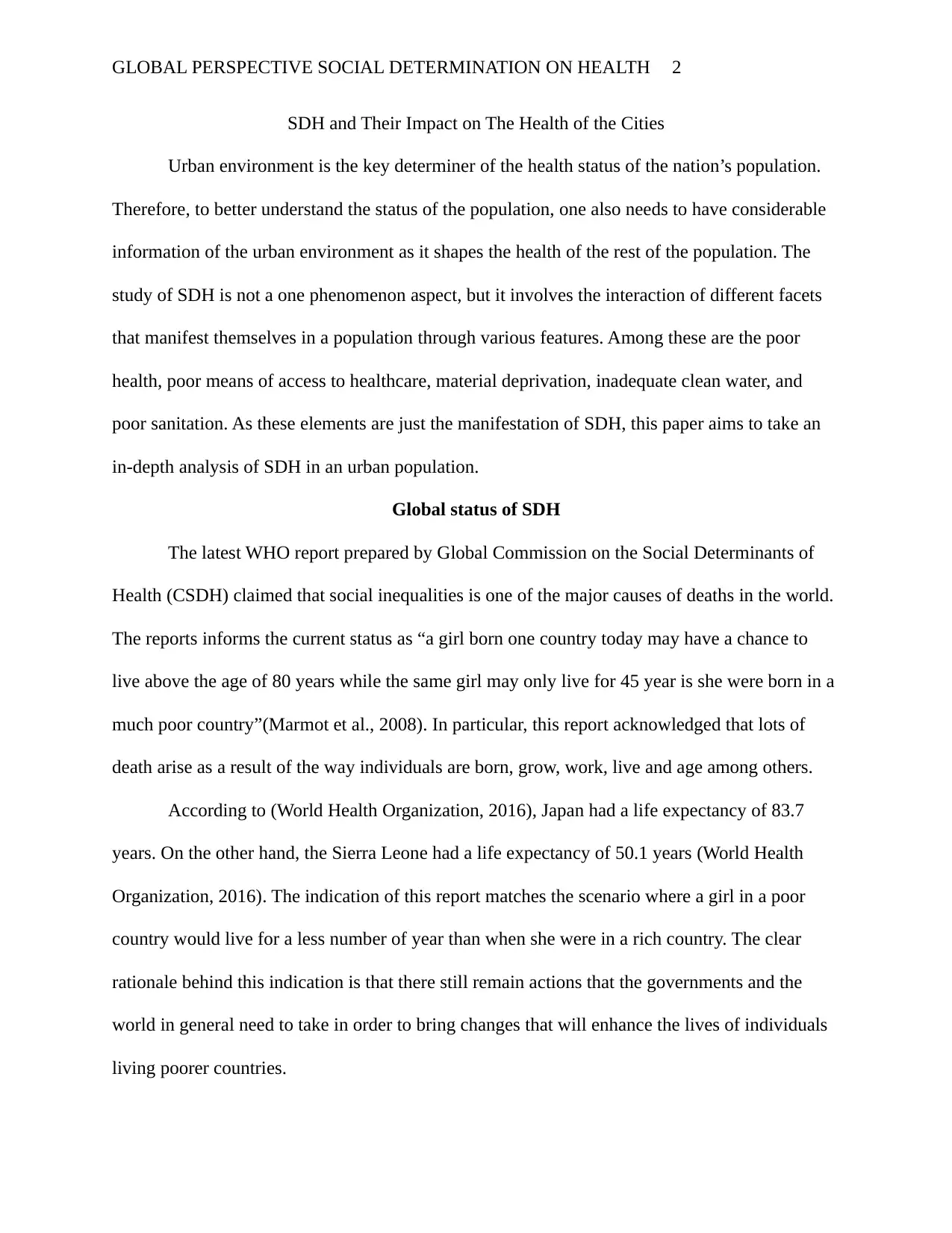
GLOBAL PERSPECTIVE SOCIAL DETERMINATION ON HEALTH 2
SDH and Their Impact on The Health of the Cities
Urban environment is the key determiner of the health status of the nation’s population.
Therefore, to better understand the status of the population, one also needs to have considerable
information of the urban environment as it shapes the health of the rest of the population. The
study of SDH is not a one phenomenon aspect, but it involves the interaction of different facets
that manifest themselves in a population through various features. Among these are the poor
health, poor means of access to healthcare, material deprivation, inadequate clean water, and
poor sanitation. As these elements are just the manifestation of SDH, this paper aims to take an
in-depth analysis of SDH in an urban population.
Global status of SDH
The latest WHO report prepared by Global Commission on the Social Determinants of
Health (CSDH) claimed that social inequalities is one of the major causes of deaths in the world.
The reports informs the current status as “a girl born one country today may have a chance to
live above the age of 80 years while the same girl may only live for 45 year is she were born in a
much poor country”(Marmot et al., 2008). In particular, this report acknowledged that lots of
death arise as a result of the way individuals are born, grow, work, live and age among others.
According to (World Health Organization, 2016), Japan had a life expectancy of 83.7
years. On the other hand, the Sierra Leone had a life expectancy of 50.1 years (World Health
Organization, 2016). The indication of this report matches the scenario where a girl in a poor
country would live for a less number of year than when she were in a rich country. The clear
rationale behind this indication is that there still remain actions that the governments and the
world in general need to take in order to bring changes that will enhance the lives of individuals
living poorer countries.
SDH and Their Impact on The Health of the Cities
Urban environment is the key determiner of the health status of the nation’s population.
Therefore, to better understand the status of the population, one also needs to have considerable
information of the urban environment as it shapes the health of the rest of the population. The
study of SDH is not a one phenomenon aspect, but it involves the interaction of different facets
that manifest themselves in a population through various features. Among these are the poor
health, poor means of access to healthcare, material deprivation, inadequate clean water, and
poor sanitation. As these elements are just the manifestation of SDH, this paper aims to take an
in-depth analysis of SDH in an urban population.
Global status of SDH
The latest WHO report prepared by Global Commission on the Social Determinants of
Health (CSDH) claimed that social inequalities is one of the major causes of deaths in the world.
The reports informs the current status as “a girl born one country today may have a chance to
live above the age of 80 years while the same girl may only live for 45 year is she were born in a
much poor country”(Marmot et al., 2008). In particular, this report acknowledged that lots of
death arise as a result of the way individuals are born, grow, work, live and age among others.
According to (World Health Organization, 2016), Japan had a life expectancy of 83.7
years. On the other hand, the Sierra Leone had a life expectancy of 50.1 years (World Health
Organization, 2016). The indication of this report matches the scenario where a girl in a poor
country would live for a less number of year than when she were in a rich country. The clear
rationale behind this indication is that there still remain actions that the governments and the
world in general need to take in order to bring changes that will enhance the lives of individuals
living poorer countries.
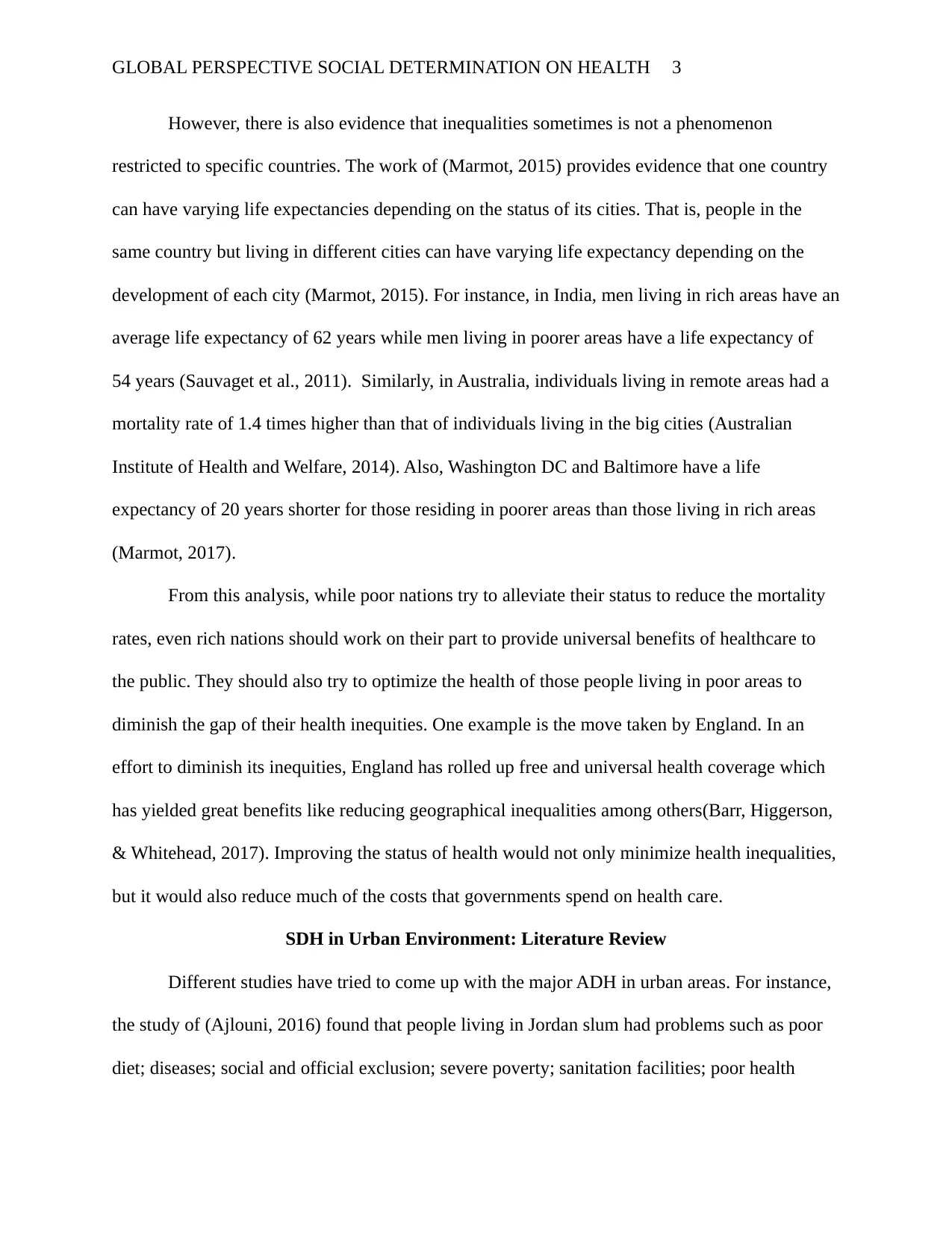
GLOBAL PERSPECTIVE SOCIAL DETERMINATION ON HEALTH 3
However, there is also evidence that inequalities sometimes is not a phenomenon
restricted to specific countries. The work of (Marmot, 2015) provides evidence that one country
can have varying life expectancies depending on the status of its cities. That is, people in the
same country but living in different cities can have varying life expectancy depending on the
development of each city (Marmot, 2015). For instance, in India, men living in rich areas have an
average life expectancy of 62 years while men living in poorer areas have a life expectancy of
54 years (Sauvaget et al., 2011). Similarly, in Australia, individuals living in remote areas had a
mortality rate of 1.4 times higher than that of individuals living in the big cities (Australian
Institute of Health and Welfare, 2014). Also, Washington DC and Baltimore have a life
expectancy of 20 years shorter for those residing in poorer areas than those living in rich areas
(Marmot, 2017).
From this analysis, while poor nations try to alleviate their status to reduce the mortality
rates, even rich nations should work on their part to provide universal benefits of healthcare to
the public. They should also try to optimize the health of those people living in poor areas to
diminish the gap of their health inequities. One example is the move taken by England. In an
effort to diminish its inequities, England has rolled up free and universal health coverage which
has yielded great benefits like reducing geographical inequalities among others(Barr, Higgerson,
& Whitehead, 2017). Improving the status of health would not only minimize health inequalities,
but it would also reduce much of the costs that governments spend on health care.
SDH in Urban Environment: Literature Review
Different studies have tried to come up with the major ADH in urban areas. For instance,
the study of (Ajlouni, 2016) found that people living in Jordan slum had problems such as poor
diet; diseases; social and official exclusion; severe poverty; sanitation facilities; poor health
However, there is also evidence that inequalities sometimes is not a phenomenon
restricted to specific countries. The work of (Marmot, 2015) provides evidence that one country
can have varying life expectancies depending on the status of its cities. That is, people in the
same country but living in different cities can have varying life expectancy depending on the
development of each city (Marmot, 2015). For instance, in India, men living in rich areas have an
average life expectancy of 62 years while men living in poorer areas have a life expectancy of
54 years (Sauvaget et al., 2011). Similarly, in Australia, individuals living in remote areas had a
mortality rate of 1.4 times higher than that of individuals living in the big cities (Australian
Institute of Health and Welfare, 2014). Also, Washington DC and Baltimore have a life
expectancy of 20 years shorter for those residing in poorer areas than those living in rich areas
(Marmot, 2017).
From this analysis, while poor nations try to alleviate their status to reduce the mortality
rates, even rich nations should work on their part to provide universal benefits of healthcare to
the public. They should also try to optimize the health of those people living in poor areas to
diminish the gap of their health inequities. One example is the move taken by England. In an
effort to diminish its inequities, England has rolled up free and universal health coverage which
has yielded great benefits like reducing geographical inequalities among others(Barr, Higgerson,
& Whitehead, 2017). Improving the status of health would not only minimize health inequalities,
but it would also reduce much of the costs that governments spend on health care.
SDH in Urban Environment: Literature Review
Different studies have tried to come up with the major ADH in urban areas. For instance,
the study of (Ajlouni, 2016) found that people living in Jordan slum had problems such as poor
diet; diseases; social and official exclusion; severe poverty; sanitation facilities; poor health
Secure Best Marks with AI Grader
Need help grading? Try our AI Grader for instant feedback on your assignments.
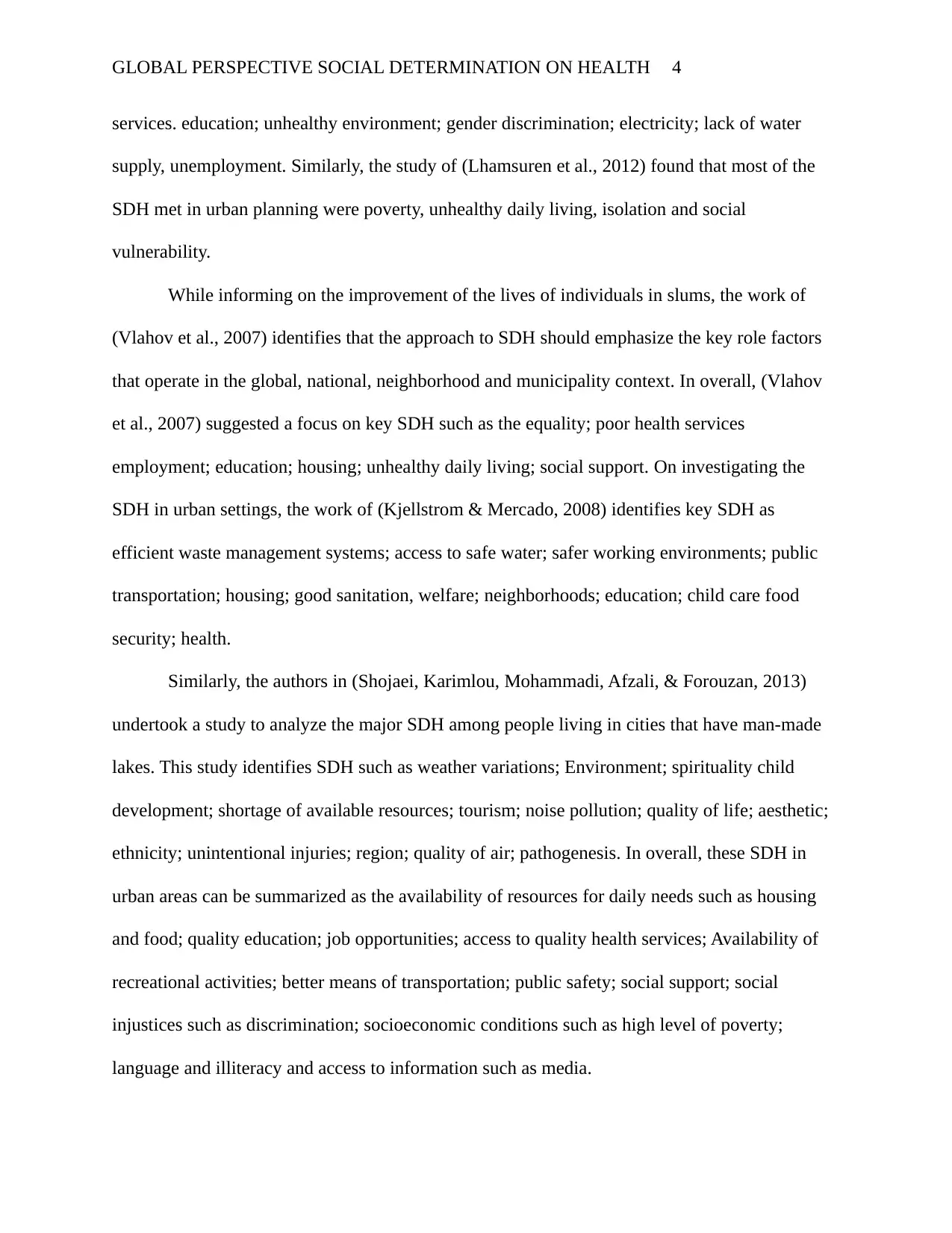
GLOBAL PERSPECTIVE SOCIAL DETERMINATION ON HEALTH 4
services. education; unhealthy environment; gender discrimination; electricity; lack of water
supply, unemployment. Similarly, the study of (Lhamsuren et al., 2012) found that most of the
SDH met in urban planning were poverty, unhealthy daily living, isolation and social
vulnerability.
While informing on the improvement of the lives of individuals in slums, the work of
(Vlahov et al., 2007) identifies that the approach to SDH should emphasize the key role factors
that operate in the global, national, neighborhood and municipality context. In overall, (Vlahov
et al., 2007) suggested a focus on key SDH such as the equality; poor health services
employment; education; housing; unhealthy daily living; social support. On investigating the
SDH in urban settings, the work of (Kjellstrom & Mercado, 2008) identifies key SDH as
efficient waste management systems; access to safe water; safer working environments; public
transportation; housing; good sanitation, welfare; neighborhoods; education; child care food
security; health.
Similarly, the authors in (Shojaei, Karimlou, Mohammadi, Afzali, & Forouzan, 2013)
undertook a study to analyze the major SDH among people living in cities that have man-made
lakes. This study identifies SDH such as weather variations; Environment; spirituality child
development; shortage of available resources; tourism; noise pollution; quality of life; aesthetic;
ethnicity; unintentional injuries; region; quality of air; pathogenesis. In overall, these SDH in
urban areas can be summarized as the availability of resources for daily needs such as housing
and food; quality education; job opportunities; access to quality health services; Availability of
recreational activities; better means of transportation; public safety; social support; social
injustices such as discrimination; socioeconomic conditions such as high level of poverty;
language and illiteracy and access to information such as media.
services. education; unhealthy environment; gender discrimination; electricity; lack of water
supply, unemployment. Similarly, the study of (Lhamsuren et al., 2012) found that most of the
SDH met in urban planning were poverty, unhealthy daily living, isolation and social
vulnerability.
While informing on the improvement of the lives of individuals in slums, the work of
(Vlahov et al., 2007) identifies that the approach to SDH should emphasize the key role factors
that operate in the global, national, neighborhood and municipality context. In overall, (Vlahov
et al., 2007) suggested a focus on key SDH such as the equality; poor health services
employment; education; housing; unhealthy daily living; social support. On investigating the
SDH in urban settings, the work of (Kjellstrom & Mercado, 2008) identifies key SDH as
efficient waste management systems; access to safe water; safer working environments; public
transportation; housing; good sanitation, welfare; neighborhoods; education; child care food
security; health.
Similarly, the authors in (Shojaei, Karimlou, Mohammadi, Afzali, & Forouzan, 2013)
undertook a study to analyze the major SDH among people living in cities that have man-made
lakes. This study identifies SDH such as weather variations; Environment; spirituality child
development; shortage of available resources; tourism; noise pollution; quality of life; aesthetic;
ethnicity; unintentional injuries; region; quality of air; pathogenesis. In overall, these SDH in
urban areas can be summarized as the availability of resources for daily needs such as housing
and food; quality education; job opportunities; access to quality health services; Availability of
recreational activities; better means of transportation; public safety; social support; social
injustices such as discrimination; socioeconomic conditions such as high level of poverty;
language and illiteracy and access to information such as media.
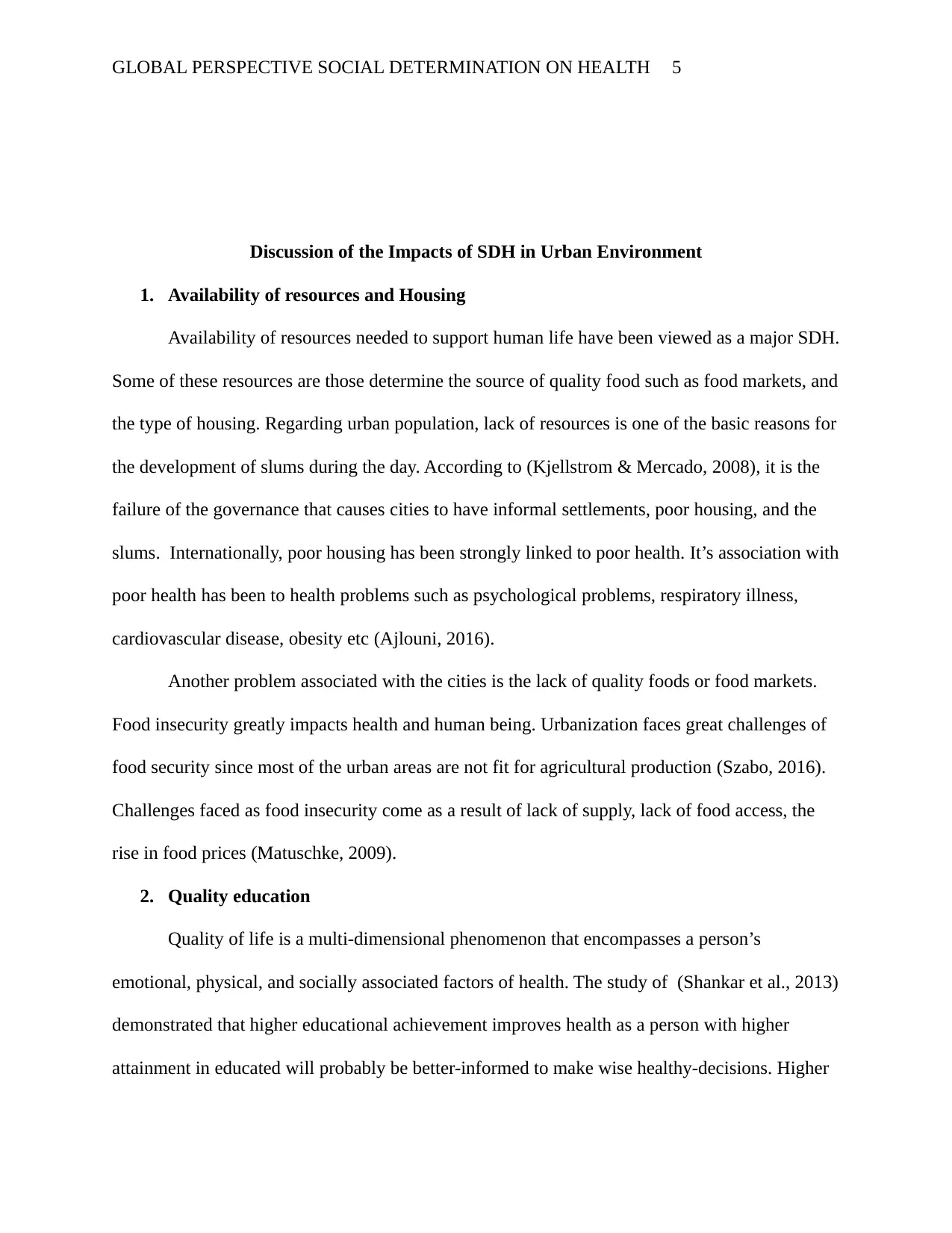
GLOBAL PERSPECTIVE SOCIAL DETERMINATION ON HEALTH 5
Discussion of the Impacts of SDH in Urban Environment
1. Availability of resources and Housing
Availability of resources needed to support human life have been viewed as a major SDH.
Some of these resources are those determine the source of quality food such as food markets, and
the type of housing. Regarding urban population, lack of resources is one of the basic reasons for
the development of slums during the day. According to (Kjellstrom & Mercado, 2008), it is the
failure of the governance that causes cities to have informal settlements, poor housing, and the
slums. Internationally, poor housing has been strongly linked to poor health. It’s association with
poor health has been to health problems such as psychological problems, respiratory illness,
cardiovascular disease, obesity etc (Ajlouni, 2016).
Another problem associated with the cities is the lack of quality foods or food markets.
Food insecurity greatly impacts health and human being. Urbanization faces great challenges of
food security since most of the urban areas are not fit for agricultural production (Szabo, 2016).
Challenges faced as food insecurity come as a result of lack of supply, lack of food access, the
rise in food prices (Matuschke, 2009).
2. Quality education
Quality of life is a multi-dimensional phenomenon that encompasses a person’s
emotional, physical, and socially associated factors of health. The study of (Shankar et al., 2013)
demonstrated that higher educational achievement improves health as a person with higher
attainment in educated will probably be better-informed to make wise healthy-decisions. Higher
Discussion of the Impacts of SDH in Urban Environment
1. Availability of resources and Housing
Availability of resources needed to support human life have been viewed as a major SDH.
Some of these resources are those determine the source of quality food such as food markets, and
the type of housing. Regarding urban population, lack of resources is one of the basic reasons for
the development of slums during the day. According to (Kjellstrom & Mercado, 2008), it is the
failure of the governance that causes cities to have informal settlements, poor housing, and the
slums. Internationally, poor housing has been strongly linked to poor health. It’s association with
poor health has been to health problems such as psychological problems, respiratory illness,
cardiovascular disease, obesity etc (Ajlouni, 2016).
Another problem associated with the cities is the lack of quality foods or food markets.
Food insecurity greatly impacts health and human being. Urbanization faces great challenges of
food security since most of the urban areas are not fit for agricultural production (Szabo, 2016).
Challenges faced as food insecurity come as a result of lack of supply, lack of food access, the
rise in food prices (Matuschke, 2009).
2. Quality education
Quality of life is a multi-dimensional phenomenon that encompasses a person’s
emotional, physical, and socially associated factors of health. The study of (Shankar et al., 2013)
demonstrated that higher educational achievement improves health as a person with higher
attainment in educated will probably be better-informed to make wise healthy-decisions. Higher
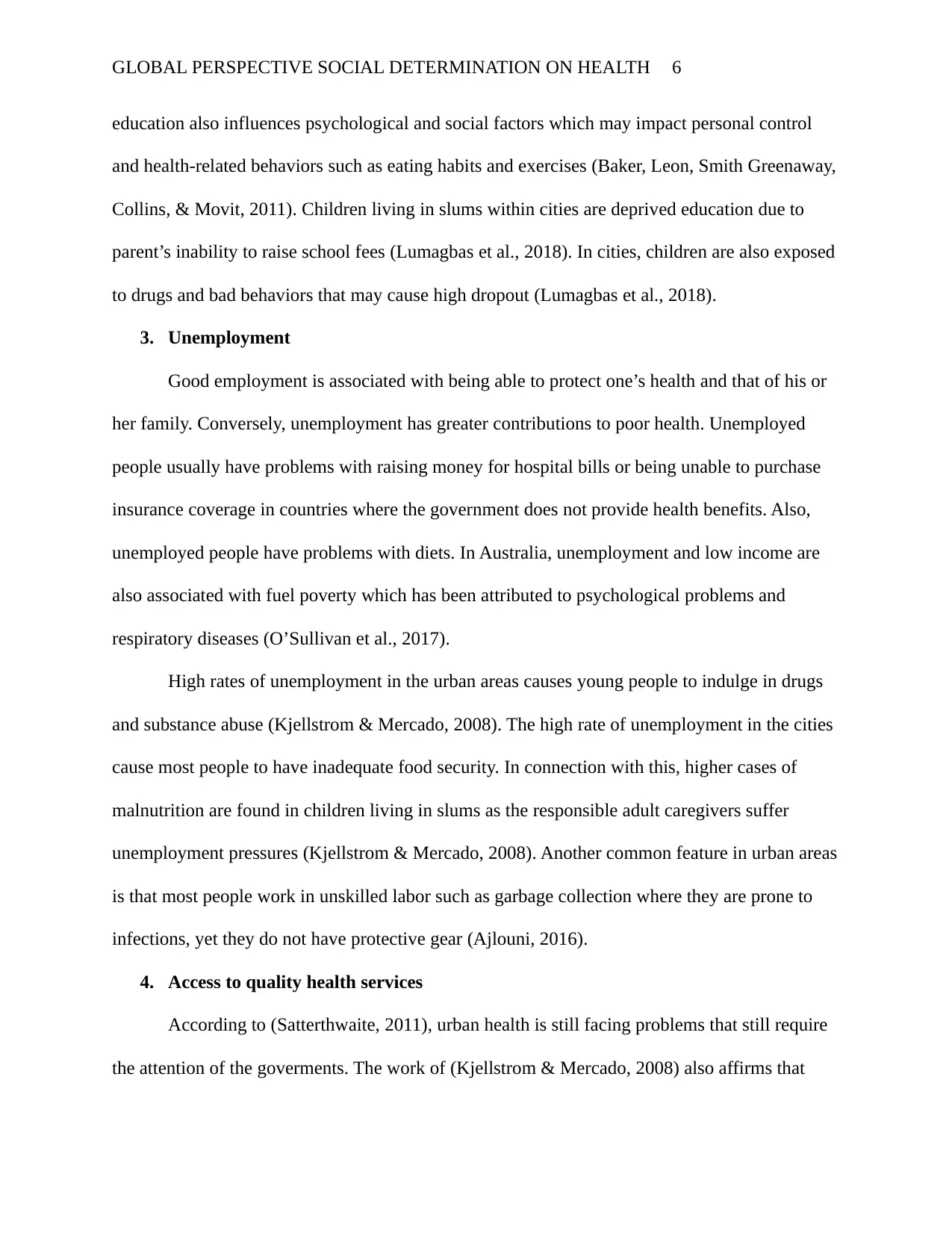
GLOBAL PERSPECTIVE SOCIAL DETERMINATION ON HEALTH 6
education also influences psychological and social factors which may impact personal control
and health-related behaviors such as eating habits and exercises (Baker, Leon, Smith Greenaway,
Collins, & Movit, 2011). Children living in slums within cities are deprived education due to
parent’s inability to raise school fees (Lumagbas et al., 2018). In cities, children are also exposed
to drugs and bad behaviors that may cause high dropout (Lumagbas et al., 2018).
3. Unemployment
Good employment is associated with being able to protect one’s health and that of his or
her family. Conversely, unemployment has greater contributions to poor health. Unemployed
people usually have problems with raising money for hospital bills or being unable to purchase
insurance coverage in countries where the government does not provide health benefits. Also,
unemployed people have problems with diets. In Australia, unemployment and low income are
also associated with fuel poverty which has been attributed to psychological problems and
respiratory diseases (O’Sullivan et al., 2017).
High rates of unemployment in the urban areas causes young people to indulge in drugs
and substance abuse (Kjellstrom & Mercado, 2008). The high rate of unemployment in the cities
cause most people to have inadequate food security. In connection with this, higher cases of
malnutrition are found in children living in slums as the responsible adult caregivers suffer
unemployment pressures (Kjellstrom & Mercado, 2008). Another common feature in urban areas
is that most people work in unskilled labor such as garbage collection where they are prone to
infections, yet they do not have protective gear (Ajlouni, 2016).
4. Access to quality health services
According to (Satterthwaite, 2011), urban health is still facing problems that still require
the attention of the goverments. The work of (Kjellstrom & Mercado, 2008) also affirms that
education also influences psychological and social factors which may impact personal control
and health-related behaviors such as eating habits and exercises (Baker, Leon, Smith Greenaway,
Collins, & Movit, 2011). Children living in slums within cities are deprived education due to
parent’s inability to raise school fees (Lumagbas et al., 2018). In cities, children are also exposed
to drugs and bad behaviors that may cause high dropout (Lumagbas et al., 2018).
3. Unemployment
Good employment is associated with being able to protect one’s health and that of his or
her family. Conversely, unemployment has greater contributions to poor health. Unemployed
people usually have problems with raising money for hospital bills or being unable to purchase
insurance coverage in countries where the government does not provide health benefits. Also,
unemployed people have problems with diets. In Australia, unemployment and low income are
also associated with fuel poverty which has been attributed to psychological problems and
respiratory diseases (O’Sullivan et al., 2017).
High rates of unemployment in the urban areas causes young people to indulge in drugs
and substance abuse (Kjellstrom & Mercado, 2008). The high rate of unemployment in the cities
cause most people to have inadequate food security. In connection with this, higher cases of
malnutrition are found in children living in slums as the responsible adult caregivers suffer
unemployment pressures (Kjellstrom & Mercado, 2008). Another common feature in urban areas
is that most people work in unskilled labor such as garbage collection where they are prone to
infections, yet they do not have protective gear (Ajlouni, 2016).
4. Access to quality health services
According to (Satterthwaite, 2011), urban health is still facing problems that still require
the attention of the goverments. The work of (Kjellstrom & Mercado, 2008) also affirms that
Paraphrase This Document
Need a fresh take? Get an instant paraphrase of this document with our AI Paraphraser
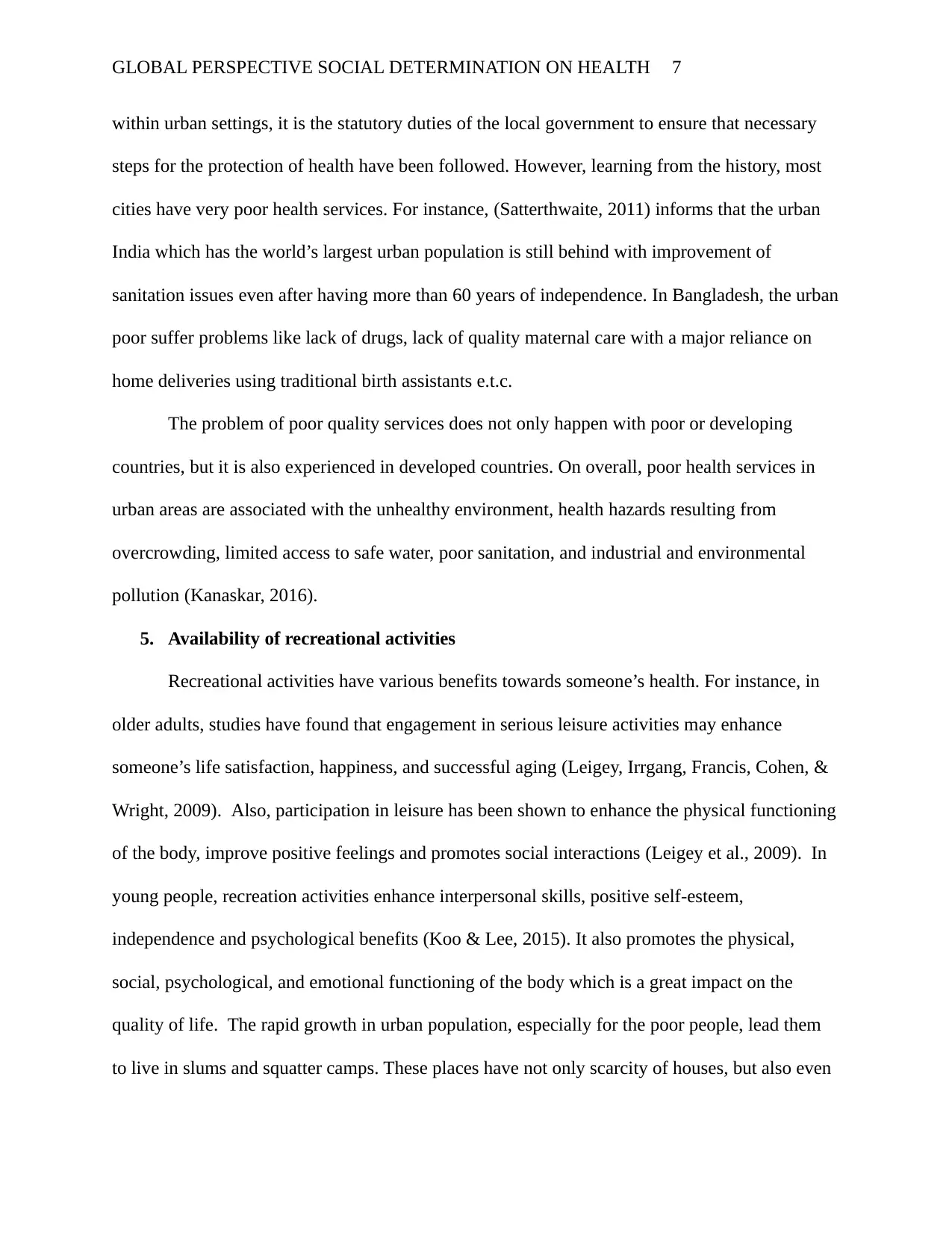
GLOBAL PERSPECTIVE SOCIAL DETERMINATION ON HEALTH 7
within urban settings, it is the statutory duties of the local government to ensure that necessary
steps for the protection of health have been followed. However, learning from the history, most
cities have very poor health services. For instance, (Satterthwaite, 2011) informs that the urban
India which has the world’s largest urban population is still behind with improvement of
sanitation issues even after having more than 60 years of independence. In Bangladesh, the urban
poor suffer problems like lack of drugs, lack of quality maternal care with a major reliance on
home deliveries using traditional birth assistants e.t.c.
The problem of poor quality services does not only happen with poor or developing
countries, but it is also experienced in developed countries. On overall, poor health services in
urban areas are associated with the unhealthy environment, health hazards resulting from
overcrowding, limited access to safe water, poor sanitation, and industrial and environmental
pollution (Kanaskar, 2016).
5. Availability of recreational activities
Recreational activities have various benefits towards someone’s health. For instance, in
older adults, studies have found that engagement in serious leisure activities may enhance
someone’s life satisfaction, happiness, and successful aging (Leigey, Irrgang, Francis, Cohen, &
Wright, 2009). Also, participation in leisure has been shown to enhance the physical functioning
of the body, improve positive feelings and promotes social interactions (Leigey et al., 2009). In
young people, recreation activities enhance interpersonal skills, positive self-esteem,
independence and psychological benefits (Koo & Lee, 2015). It also promotes the physical,
social, psychological, and emotional functioning of the body which is a great impact on the
quality of life. The rapid growth in urban population, especially for the poor people, lead them
to live in slums and squatter camps. These places have not only scarcity of houses, but also even
within urban settings, it is the statutory duties of the local government to ensure that necessary
steps for the protection of health have been followed. However, learning from the history, most
cities have very poor health services. For instance, (Satterthwaite, 2011) informs that the urban
India which has the world’s largest urban population is still behind with improvement of
sanitation issues even after having more than 60 years of independence. In Bangladesh, the urban
poor suffer problems like lack of drugs, lack of quality maternal care with a major reliance on
home deliveries using traditional birth assistants e.t.c.
The problem of poor quality services does not only happen with poor or developing
countries, but it is also experienced in developed countries. On overall, poor health services in
urban areas are associated with the unhealthy environment, health hazards resulting from
overcrowding, limited access to safe water, poor sanitation, and industrial and environmental
pollution (Kanaskar, 2016).
5. Availability of recreational activities
Recreational activities have various benefits towards someone’s health. For instance, in
older adults, studies have found that engagement in serious leisure activities may enhance
someone’s life satisfaction, happiness, and successful aging (Leigey, Irrgang, Francis, Cohen, &
Wright, 2009). Also, participation in leisure has been shown to enhance the physical functioning
of the body, improve positive feelings and promotes social interactions (Leigey et al., 2009). In
young people, recreation activities enhance interpersonal skills, positive self-esteem,
independence and psychological benefits (Koo & Lee, 2015). It also promotes the physical,
social, psychological, and emotional functioning of the body which is a great impact on the
quality of life. The rapid growth in urban population, especially for the poor people, lead them
to live in slums and squatter camps. These places have not only scarcity of houses, but also even
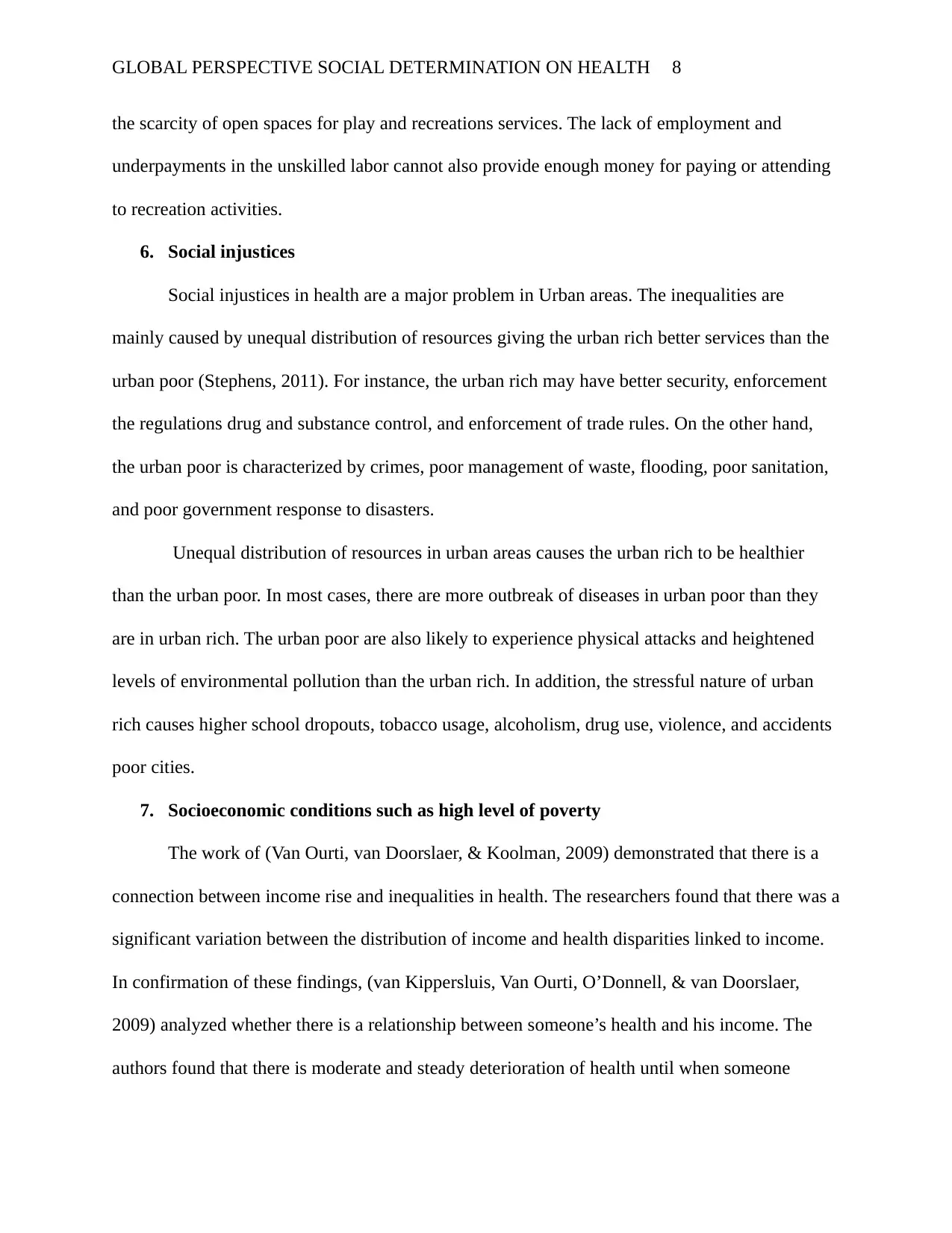
GLOBAL PERSPECTIVE SOCIAL DETERMINATION ON HEALTH 8
the scarcity of open spaces for play and recreations services. The lack of employment and
underpayments in the unskilled labor cannot also provide enough money for paying or attending
to recreation activities.
6. Social injustices
Social injustices in health are a major problem in Urban areas. The inequalities are
mainly caused by unequal distribution of resources giving the urban rich better services than the
urban poor (Stephens, 2011). For instance, the urban rich may have better security, enforcement
the regulations drug and substance control, and enforcement of trade rules. On the other hand,
the urban poor is characterized by crimes, poor management of waste, flooding, poor sanitation,
and poor government response to disasters.
Unequal distribution of resources in urban areas causes the urban rich to be healthier
than the urban poor. In most cases, there are more outbreak of diseases in urban poor than they
are in urban rich. The urban poor are also likely to experience physical attacks and heightened
levels of environmental pollution than the urban rich. In addition, the stressful nature of urban
rich causes higher school dropouts, tobacco usage, alcoholism, drug use, violence, and accidents
poor cities.
7. Socioeconomic conditions such as high level of poverty
The work of (Van Ourti, van Doorslaer, & Koolman, 2009) demonstrated that there is a
connection between income rise and inequalities in health. The researchers found that there was a
significant variation between the distribution of income and health disparities linked to income.
In confirmation of these findings, (van Kippersluis, Van Ourti, O’Donnell, & van Doorslaer,
2009) analyzed whether there is a relationship between someone’s health and his income. The
authors found that there is moderate and steady deterioration of health until when someone
the scarcity of open spaces for play and recreations services. The lack of employment and
underpayments in the unskilled labor cannot also provide enough money for paying or attending
to recreation activities.
6. Social injustices
Social injustices in health are a major problem in Urban areas. The inequalities are
mainly caused by unequal distribution of resources giving the urban rich better services than the
urban poor (Stephens, 2011). For instance, the urban rich may have better security, enforcement
the regulations drug and substance control, and enforcement of trade rules. On the other hand,
the urban poor is characterized by crimes, poor management of waste, flooding, poor sanitation,
and poor government response to disasters.
Unequal distribution of resources in urban areas causes the urban rich to be healthier
than the urban poor. In most cases, there are more outbreak of diseases in urban poor than they
are in urban rich. The urban poor are also likely to experience physical attacks and heightened
levels of environmental pollution than the urban rich. In addition, the stressful nature of urban
rich causes higher school dropouts, tobacco usage, alcoholism, drug use, violence, and accidents
poor cities.
7. Socioeconomic conditions such as high level of poverty
The work of (Van Ourti, van Doorslaer, & Koolman, 2009) demonstrated that there is a
connection between income rise and inequalities in health. The researchers found that there was a
significant variation between the distribution of income and health disparities linked to income.
In confirmation of these findings, (van Kippersluis, Van Ourti, O’Donnell, & van Doorslaer,
2009) analyzed whether there is a relationship between someone’s health and his income. The
authors found that there is moderate and steady deterioration of health until when someone
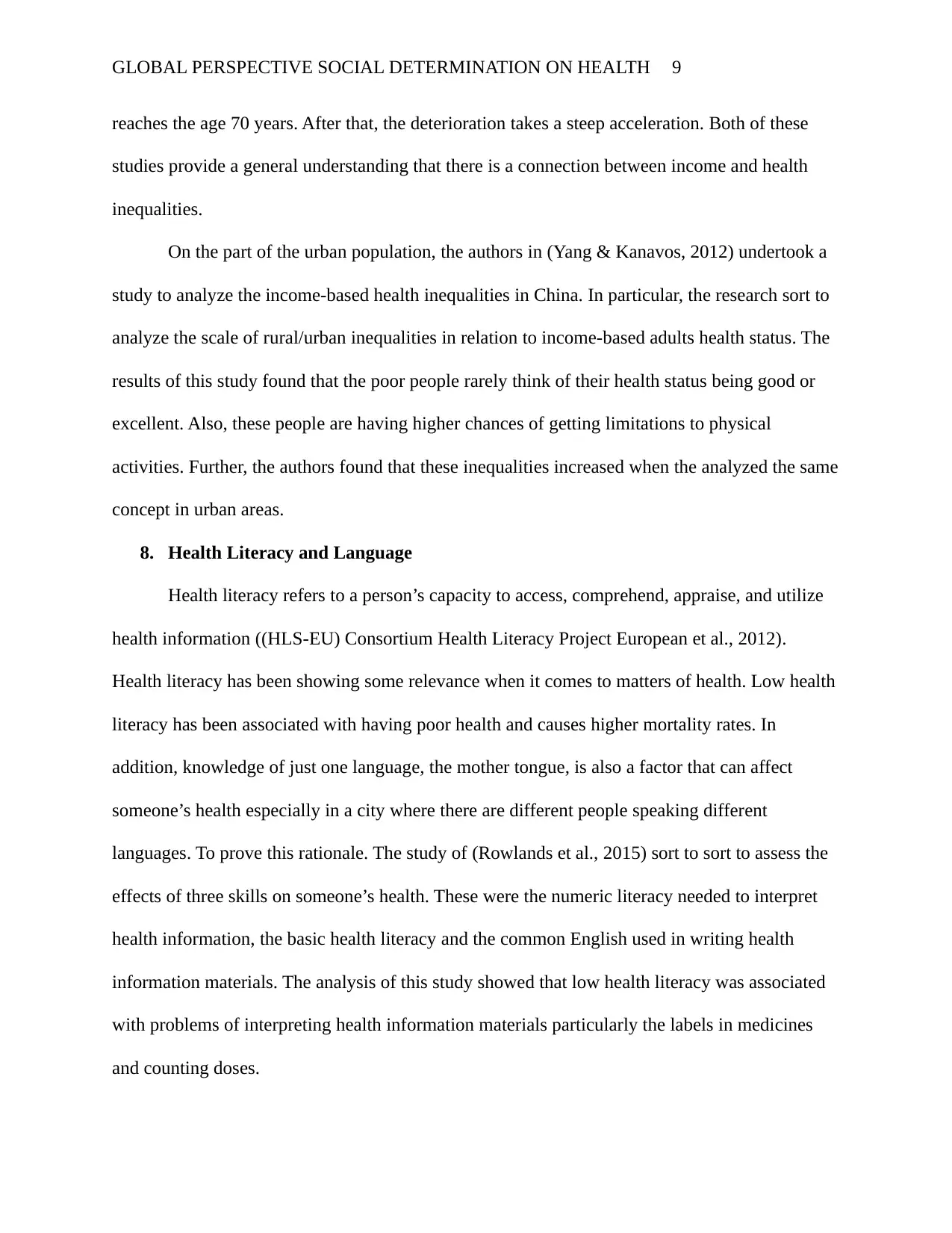
GLOBAL PERSPECTIVE SOCIAL DETERMINATION ON HEALTH 9
reaches the age 70 years. After that, the deterioration takes a steep acceleration. Both of these
studies provide a general understanding that there is a connection between income and health
inequalities.
On the part of the urban population, the authors in (Yang & Kanavos, 2012) undertook a
study to analyze the income-based health inequalities in China. In particular, the research sort to
analyze the scale of rural/urban inequalities in relation to income-based adults health status. The
results of this study found that the poor people rarely think of their health status being good or
excellent. Also, these people are having higher chances of getting limitations to physical
activities. Further, the authors found that these inequalities increased when the analyzed the same
concept in urban areas.
8. Health Literacy and Language
Health literacy refers to a person’s capacity to access, comprehend, appraise, and utilize
health information ((HLS-EU) Consortium Health Literacy Project European et al., 2012).
Health literacy has been showing some relevance when it comes to matters of health. Low health
literacy has been associated with having poor health and causes higher mortality rates. In
addition, knowledge of just one language, the mother tongue, is also a factor that can affect
someone’s health especially in a city where there are different people speaking different
languages. To prove this rationale. The study of (Rowlands et al., 2015) sort to sort to assess the
effects of three skills on someone’s health. These were the numeric literacy needed to interpret
health information, the basic health literacy and the common English used in writing health
information materials. The analysis of this study showed that low health literacy was associated
with problems of interpreting health information materials particularly the labels in medicines
and counting doses.
reaches the age 70 years. After that, the deterioration takes a steep acceleration. Both of these
studies provide a general understanding that there is a connection between income and health
inequalities.
On the part of the urban population, the authors in (Yang & Kanavos, 2012) undertook a
study to analyze the income-based health inequalities in China. In particular, the research sort to
analyze the scale of rural/urban inequalities in relation to income-based adults health status. The
results of this study found that the poor people rarely think of their health status being good or
excellent. Also, these people are having higher chances of getting limitations to physical
activities. Further, the authors found that these inequalities increased when the analyzed the same
concept in urban areas.
8. Health Literacy and Language
Health literacy refers to a person’s capacity to access, comprehend, appraise, and utilize
health information ((HLS-EU) Consortium Health Literacy Project European et al., 2012).
Health literacy has been showing some relevance when it comes to matters of health. Low health
literacy has been associated with having poor health and causes higher mortality rates. In
addition, knowledge of just one language, the mother tongue, is also a factor that can affect
someone’s health especially in a city where there are different people speaking different
languages. To prove this rationale. The study of (Rowlands et al., 2015) sort to sort to assess the
effects of three skills on someone’s health. These were the numeric literacy needed to interpret
health information, the basic health literacy and the common English used in writing health
information materials. The analysis of this study showed that low health literacy was associated
with problems of interpreting health information materials particularly the labels in medicines
and counting doses.
Secure Best Marks with AI Grader
Need help grading? Try our AI Grader for instant feedback on your assignments.
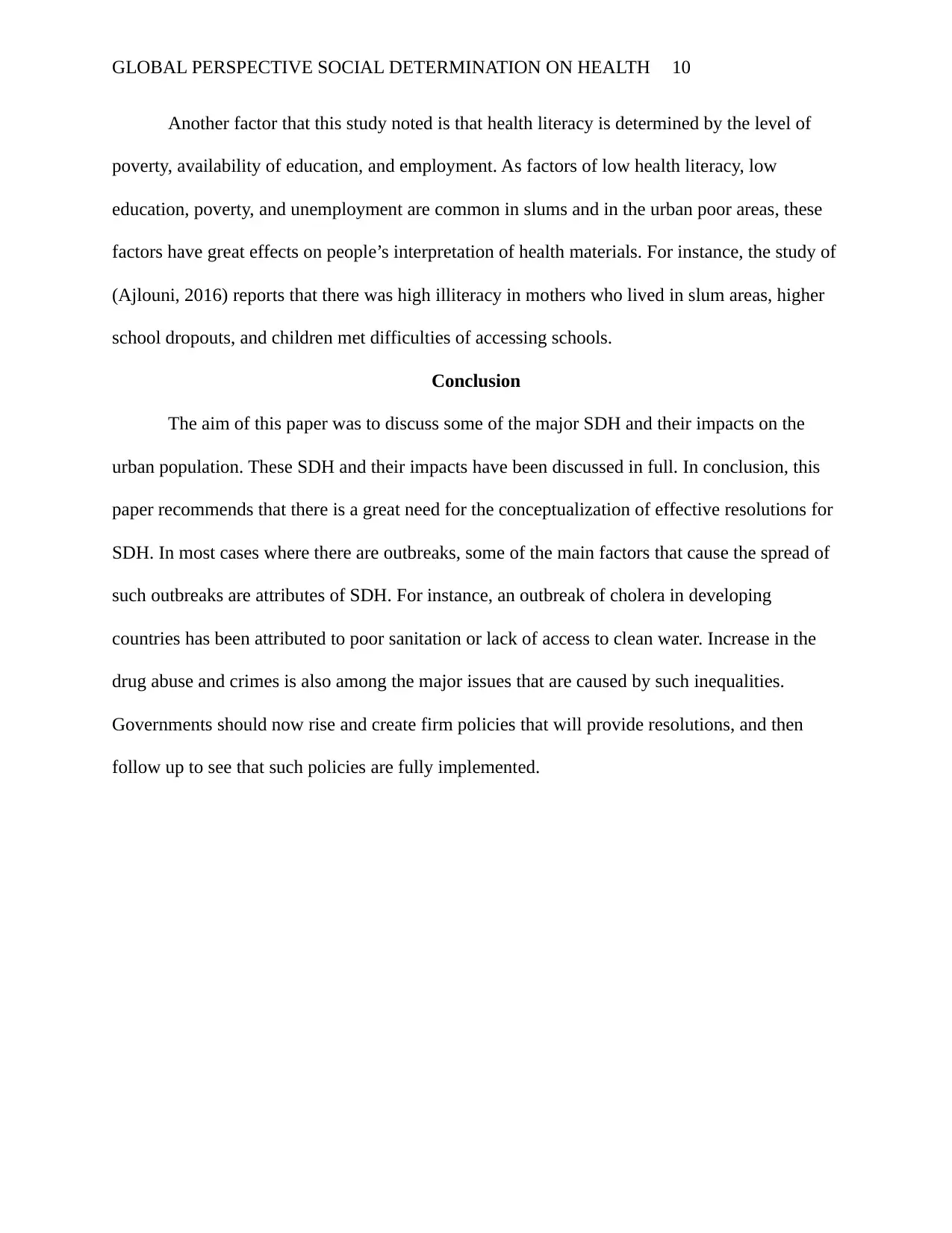
GLOBAL PERSPECTIVE SOCIAL DETERMINATION ON HEALTH 10
Another factor that this study noted is that health literacy is determined by the level of
poverty, availability of education, and employment. As factors of low health literacy, low
education, poverty, and unemployment are common in slums and in the urban poor areas, these
factors have great effects on people’s interpretation of health materials. For instance, the study of
(Ajlouni, 2016) reports that there was high illiteracy in mothers who lived in slum areas, higher
school dropouts, and children met difficulties of accessing schools.
Conclusion
The aim of this paper was to discuss some of the major SDH and their impacts on the
urban population. These SDH and their impacts have been discussed in full. In conclusion, this
paper recommends that there is a great need for the conceptualization of effective resolutions for
SDH. In most cases where there are outbreaks, some of the main factors that cause the spread of
such outbreaks are attributes of SDH. For instance, an outbreak of cholera in developing
countries has been attributed to poor sanitation or lack of access to clean water. Increase in the
drug abuse and crimes is also among the major issues that are caused by such inequalities.
Governments should now rise and create firm policies that will provide resolutions, and then
follow up to see that such policies are fully implemented.
Another factor that this study noted is that health literacy is determined by the level of
poverty, availability of education, and employment. As factors of low health literacy, low
education, poverty, and unemployment are common in slums and in the urban poor areas, these
factors have great effects on people’s interpretation of health materials. For instance, the study of
(Ajlouni, 2016) reports that there was high illiteracy in mothers who lived in slum areas, higher
school dropouts, and children met difficulties of accessing schools.
Conclusion
The aim of this paper was to discuss some of the major SDH and their impacts on the
urban population. These SDH and their impacts have been discussed in full. In conclusion, this
paper recommends that there is a great need for the conceptualization of effective resolutions for
SDH. In most cases where there are outbreaks, some of the main factors that cause the spread of
such outbreaks are attributes of SDH. For instance, an outbreak of cholera in developing
countries has been attributed to poor sanitation or lack of access to clean water. Increase in the
drug abuse and crimes is also among the major issues that are caused by such inequalities.
Governments should now rise and create firm policies that will provide resolutions, and then
follow up to see that such policies are fully implemented.
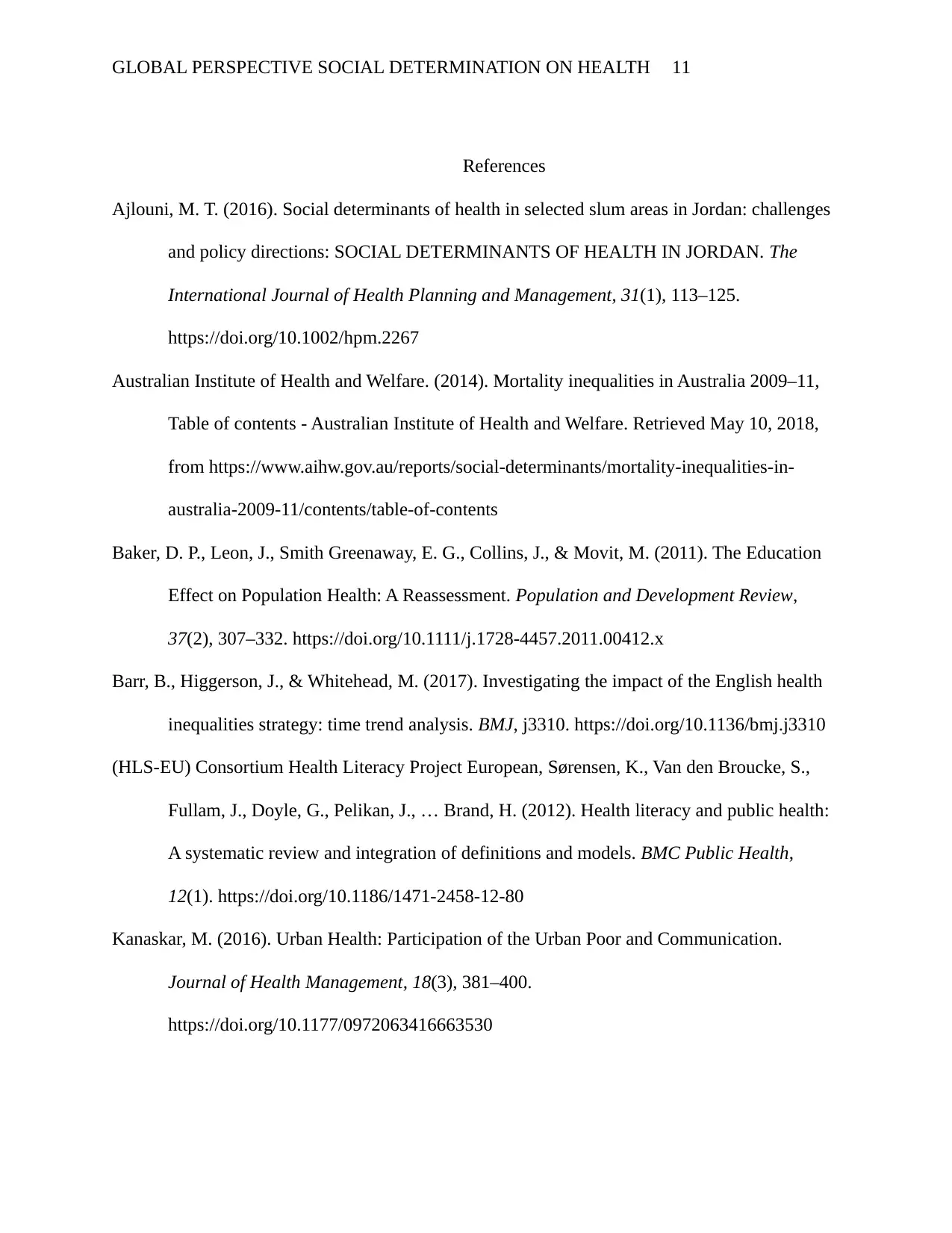
GLOBAL PERSPECTIVE SOCIAL DETERMINATION ON HEALTH 11
References
Ajlouni, M. T. (2016). Social determinants of health in selected slum areas in Jordan: challenges
and policy directions: SOCIAL DETERMINANTS OF HEALTH IN JORDAN. The
International Journal of Health Planning and Management, 31(1), 113–125.
https://doi.org/10.1002/hpm.2267
Australian Institute of Health and Welfare. (2014). Mortality inequalities in Australia 2009–11,
Table of contents - Australian Institute of Health and Welfare. Retrieved May 10, 2018,
from https://www.aihw.gov.au/reports/social-determinants/mortality-inequalities-in-
australia-2009-11/contents/table-of-contents
Baker, D. P., Leon, J., Smith Greenaway, E. G., Collins, J., & Movit, M. (2011). The Education
Effect on Population Health: A Reassessment. Population and Development Review,
37(2), 307–332. https://doi.org/10.1111/j.1728-4457.2011.00412.x
Barr, B., Higgerson, J., & Whitehead, M. (2017). Investigating the impact of the English health
inequalities strategy: time trend analysis. BMJ, j3310. https://doi.org/10.1136/bmj.j3310
(HLS-EU) Consortium Health Literacy Project European, Sørensen, K., Van den Broucke, S.,
Fullam, J., Doyle, G., Pelikan, J., … Brand, H. (2012). Health literacy and public health:
A systematic review and integration of definitions and models. BMC Public Health,
12(1). https://doi.org/10.1186/1471-2458-12-80
Kanaskar, M. (2016). Urban Health: Participation of the Urban Poor and Communication.
Journal of Health Management, 18(3), 381–400.
https://doi.org/10.1177/0972063416663530
References
Ajlouni, M. T. (2016). Social determinants of health in selected slum areas in Jordan: challenges
and policy directions: SOCIAL DETERMINANTS OF HEALTH IN JORDAN. The
International Journal of Health Planning and Management, 31(1), 113–125.
https://doi.org/10.1002/hpm.2267
Australian Institute of Health and Welfare. (2014). Mortality inequalities in Australia 2009–11,
Table of contents - Australian Institute of Health and Welfare. Retrieved May 10, 2018,
from https://www.aihw.gov.au/reports/social-determinants/mortality-inequalities-in-
australia-2009-11/contents/table-of-contents
Baker, D. P., Leon, J., Smith Greenaway, E. G., Collins, J., & Movit, M. (2011). The Education
Effect on Population Health: A Reassessment. Population and Development Review,
37(2), 307–332. https://doi.org/10.1111/j.1728-4457.2011.00412.x
Barr, B., Higgerson, J., & Whitehead, M. (2017). Investigating the impact of the English health
inequalities strategy: time trend analysis. BMJ, j3310. https://doi.org/10.1136/bmj.j3310
(HLS-EU) Consortium Health Literacy Project European, Sørensen, K., Van den Broucke, S.,
Fullam, J., Doyle, G., Pelikan, J., … Brand, H. (2012). Health literacy and public health:
A systematic review and integration of definitions and models. BMC Public Health,
12(1). https://doi.org/10.1186/1471-2458-12-80
Kanaskar, M. (2016). Urban Health: Participation of the Urban Poor and Communication.
Journal of Health Management, 18(3), 381–400.
https://doi.org/10.1177/0972063416663530
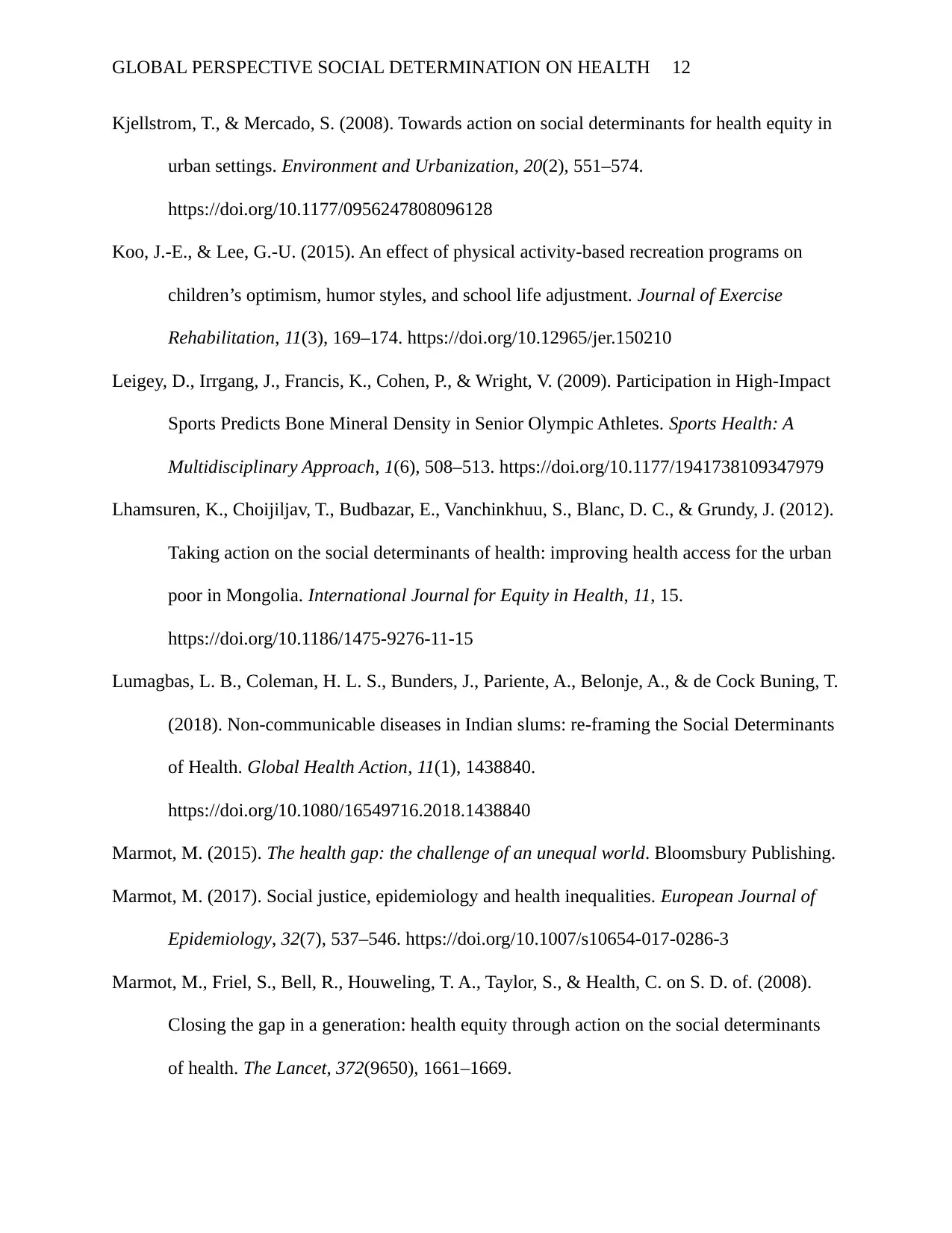
GLOBAL PERSPECTIVE SOCIAL DETERMINATION ON HEALTH 12
Kjellstrom, T., & Mercado, S. (2008). Towards action on social determinants for health equity in
urban settings. Environment and Urbanization, 20(2), 551–574.
https://doi.org/10.1177/0956247808096128
Koo, J.-E., & Lee, G.-U. (2015). An effect of physical activity-based recreation programs on
children’s optimism, humor styles, and school life adjustment. Journal of Exercise
Rehabilitation, 11(3), 169–174. https://doi.org/10.12965/jer.150210
Leigey, D., Irrgang, J., Francis, K., Cohen, P., & Wright, V. (2009). Participation in High-Impact
Sports Predicts Bone Mineral Density in Senior Olympic Athletes. Sports Health: A
Multidisciplinary Approach, 1(6), 508–513. https://doi.org/10.1177/1941738109347979
Lhamsuren, K., Choijiljav, T., Budbazar, E., Vanchinkhuu, S., Blanc, D. C., & Grundy, J. (2012).
Taking action on the social determinants of health: improving health access for the urban
poor in Mongolia. International Journal for Equity in Health, 11, 15.
https://doi.org/10.1186/1475-9276-11-15
Lumagbas, L. B., Coleman, H. L. S., Bunders, J., Pariente, A., Belonje, A., & de Cock Buning, T.
(2018). Non-communicable diseases in Indian slums: re-framing the Social Determinants
of Health. Global Health Action, 11(1), 1438840.
https://doi.org/10.1080/16549716.2018.1438840
Marmot, M. (2015). The health gap: the challenge of an unequal world. Bloomsbury Publishing.
Marmot, M. (2017). Social justice, epidemiology and health inequalities. European Journal of
Epidemiology, 32(7), 537–546. https://doi.org/10.1007/s10654-017-0286-3
Marmot, M., Friel, S., Bell, R., Houweling, T. A., Taylor, S., & Health, C. on S. D. of. (2008).
Closing the gap in a generation: health equity through action on the social determinants
of health. The Lancet, 372(9650), 1661–1669.
Kjellstrom, T., & Mercado, S. (2008). Towards action on social determinants for health equity in
urban settings. Environment and Urbanization, 20(2), 551–574.
https://doi.org/10.1177/0956247808096128
Koo, J.-E., & Lee, G.-U. (2015). An effect of physical activity-based recreation programs on
children’s optimism, humor styles, and school life adjustment. Journal of Exercise
Rehabilitation, 11(3), 169–174. https://doi.org/10.12965/jer.150210
Leigey, D., Irrgang, J., Francis, K., Cohen, P., & Wright, V. (2009). Participation in High-Impact
Sports Predicts Bone Mineral Density in Senior Olympic Athletes. Sports Health: A
Multidisciplinary Approach, 1(6), 508–513. https://doi.org/10.1177/1941738109347979
Lhamsuren, K., Choijiljav, T., Budbazar, E., Vanchinkhuu, S., Blanc, D. C., & Grundy, J. (2012).
Taking action on the social determinants of health: improving health access for the urban
poor in Mongolia. International Journal for Equity in Health, 11, 15.
https://doi.org/10.1186/1475-9276-11-15
Lumagbas, L. B., Coleman, H. L. S., Bunders, J., Pariente, A., Belonje, A., & de Cock Buning, T.
(2018). Non-communicable diseases in Indian slums: re-framing the Social Determinants
of Health. Global Health Action, 11(1), 1438840.
https://doi.org/10.1080/16549716.2018.1438840
Marmot, M. (2015). The health gap: the challenge of an unequal world. Bloomsbury Publishing.
Marmot, M. (2017). Social justice, epidemiology and health inequalities. European Journal of
Epidemiology, 32(7), 537–546. https://doi.org/10.1007/s10654-017-0286-3
Marmot, M., Friel, S., Bell, R., Houweling, T. A., Taylor, S., & Health, C. on S. D. of. (2008).
Closing the gap in a generation: health equity through action on the social determinants
of health. The Lancet, 372(9650), 1661–1669.
Paraphrase This Document
Need a fresh take? Get an instant paraphrase of this document with our AI Paraphraser
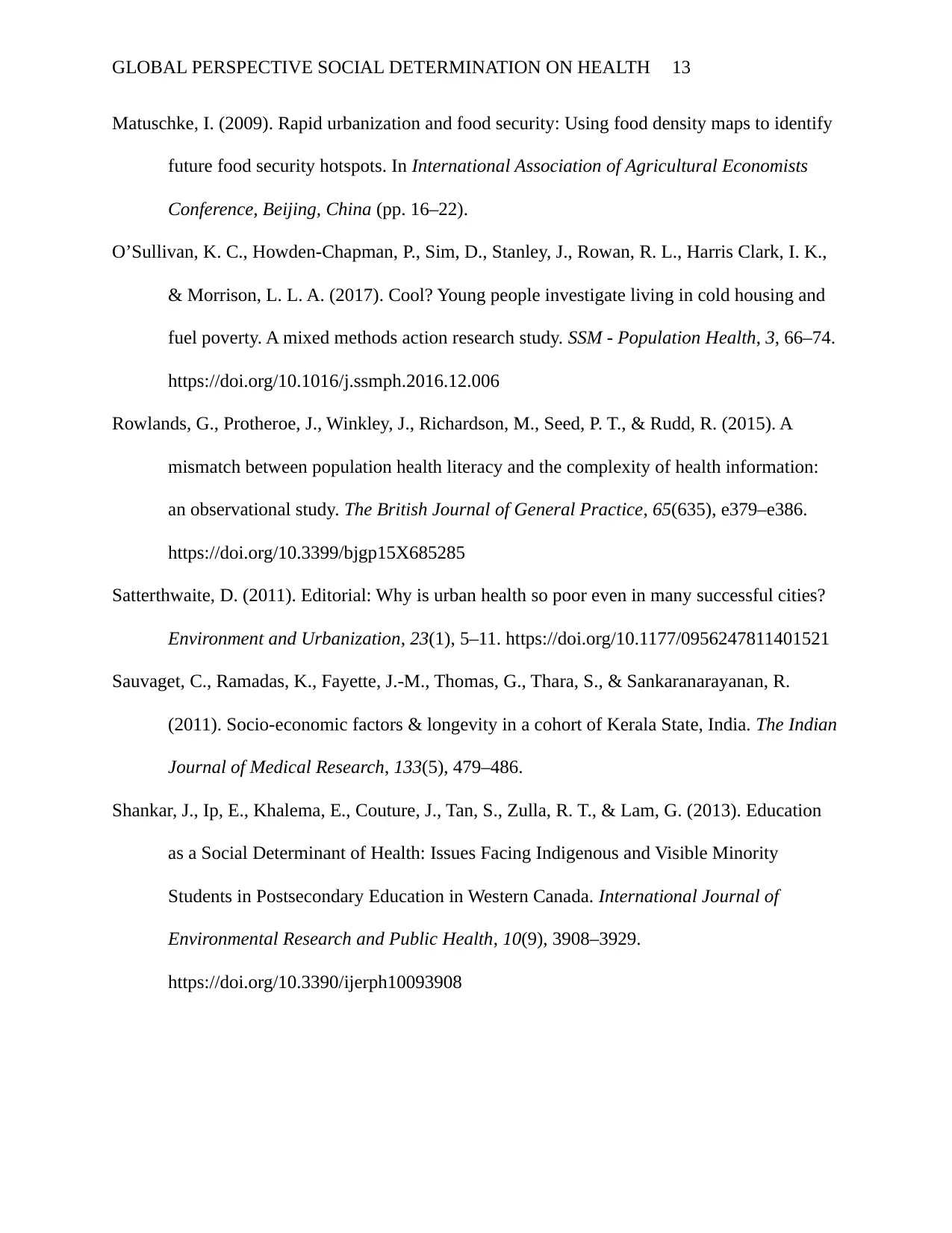
GLOBAL PERSPECTIVE SOCIAL DETERMINATION ON HEALTH 13
Matuschke, I. (2009). Rapid urbanization and food security: Using food density maps to identify
future food security hotspots. In International Association of Agricultural Economists
Conference, Beijing, China (pp. 16–22).
O’Sullivan, K. C., Howden-Chapman, P., Sim, D., Stanley, J., Rowan, R. L., Harris Clark, I. K.,
& Morrison, L. L. A. (2017). Cool? Young people investigate living in cold housing and
fuel poverty. A mixed methods action research study. SSM - Population Health, 3, 66–74.
https://doi.org/10.1016/j.ssmph.2016.12.006
Rowlands, G., Protheroe, J., Winkley, J., Richardson, M., Seed, P. T., & Rudd, R. (2015). A
mismatch between population health literacy and the complexity of health information:
an observational study. The British Journal of General Practice, 65(635), e379–e386.
https://doi.org/10.3399/bjgp15X685285
Satterthwaite, D. (2011). Editorial: Why is urban health so poor even in many successful cities?
Environment and Urbanization, 23(1), 5–11. https://doi.org/10.1177/0956247811401521
Sauvaget, C., Ramadas, K., Fayette, J.-M., Thomas, G., Thara, S., & Sankaranarayanan, R.
(2011). Socio-economic factors & longevity in a cohort of Kerala State, India. The Indian
Journal of Medical Research, 133(5), 479–486.
Shankar, J., Ip, E., Khalema, E., Couture, J., Tan, S., Zulla, R. T., & Lam, G. (2013). Education
as a Social Determinant of Health: Issues Facing Indigenous and Visible Minority
Students in Postsecondary Education in Western Canada. International Journal of
Environmental Research and Public Health, 10(9), 3908–3929.
https://doi.org/10.3390/ijerph10093908
Matuschke, I. (2009). Rapid urbanization and food security: Using food density maps to identify
future food security hotspots. In International Association of Agricultural Economists
Conference, Beijing, China (pp. 16–22).
O’Sullivan, K. C., Howden-Chapman, P., Sim, D., Stanley, J., Rowan, R. L., Harris Clark, I. K.,
& Morrison, L. L. A. (2017). Cool? Young people investigate living in cold housing and
fuel poverty. A mixed methods action research study. SSM - Population Health, 3, 66–74.
https://doi.org/10.1016/j.ssmph.2016.12.006
Rowlands, G., Protheroe, J., Winkley, J., Richardson, M., Seed, P. T., & Rudd, R. (2015). A
mismatch between population health literacy and the complexity of health information:
an observational study. The British Journal of General Practice, 65(635), e379–e386.
https://doi.org/10.3399/bjgp15X685285
Satterthwaite, D. (2011). Editorial: Why is urban health so poor even in many successful cities?
Environment and Urbanization, 23(1), 5–11. https://doi.org/10.1177/0956247811401521
Sauvaget, C., Ramadas, K., Fayette, J.-M., Thomas, G., Thara, S., & Sankaranarayanan, R.
(2011). Socio-economic factors & longevity in a cohort of Kerala State, India. The Indian
Journal of Medical Research, 133(5), 479–486.
Shankar, J., Ip, E., Khalema, E., Couture, J., Tan, S., Zulla, R. T., & Lam, G. (2013). Education
as a Social Determinant of Health: Issues Facing Indigenous and Visible Minority
Students in Postsecondary Education in Western Canada. International Journal of
Environmental Research and Public Health, 10(9), 3908–3929.
https://doi.org/10.3390/ijerph10093908
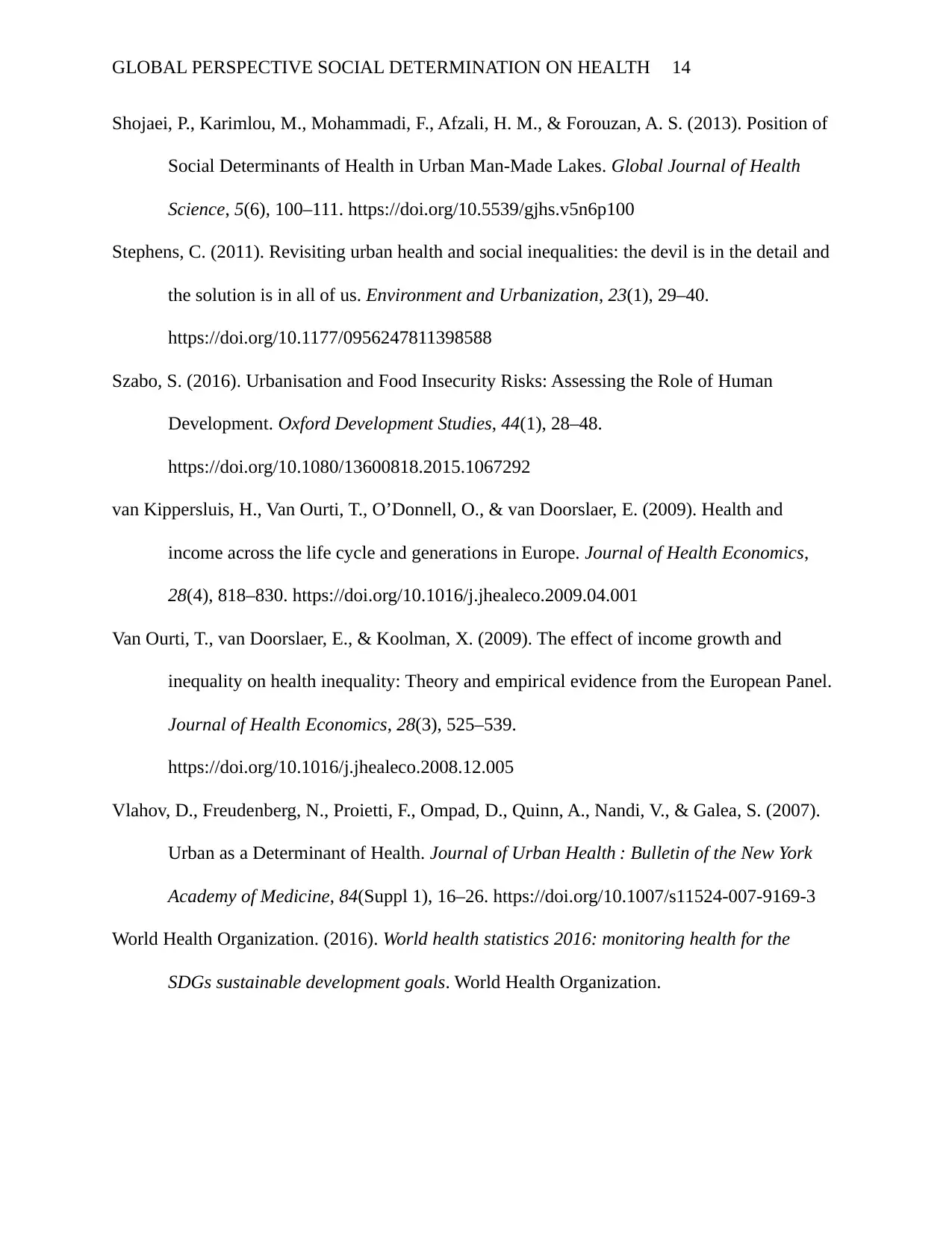
GLOBAL PERSPECTIVE SOCIAL DETERMINATION ON HEALTH 14
Shojaei, P., Karimlou, M., Mohammadi, F., Afzali, H. M., & Forouzan, A. S. (2013). Position of
Social Determinants of Health in Urban Man-Made Lakes. Global Journal of Health
Science, 5(6), 100–111. https://doi.org/10.5539/gjhs.v5n6p100
Stephens, C. (2011). Revisiting urban health and social inequalities: the devil is in the detail and
the solution is in all of us. Environment and Urbanization, 23(1), 29–40.
https://doi.org/10.1177/0956247811398588
Szabo, S. (2016). Urbanisation and Food Insecurity Risks: Assessing the Role of Human
Development. Oxford Development Studies, 44(1), 28–48.
https://doi.org/10.1080/13600818.2015.1067292
van Kippersluis, H., Van Ourti, T., O’Donnell, O., & van Doorslaer, E. (2009). Health and
income across the life cycle and generations in Europe. Journal of Health Economics,
28(4), 818–830. https://doi.org/10.1016/j.jhealeco.2009.04.001
Van Ourti, T., van Doorslaer, E., & Koolman, X. (2009). The effect of income growth and
inequality on health inequality: Theory and empirical evidence from the European Panel.
Journal of Health Economics, 28(3), 525–539.
https://doi.org/10.1016/j.jhealeco.2008.12.005
Vlahov, D., Freudenberg, N., Proietti, F., Ompad, D., Quinn, A., Nandi, V., & Galea, S. (2007).
Urban as a Determinant of Health. Journal of Urban Health : Bulletin of the New York
Academy of Medicine, 84(Suppl 1), 16–26. https://doi.org/10.1007/s11524-007-9169-3
World Health Organization. (2016). World health statistics 2016: monitoring health for the
SDGs sustainable development goals. World Health Organization.
Shojaei, P., Karimlou, M., Mohammadi, F., Afzali, H. M., & Forouzan, A. S. (2013). Position of
Social Determinants of Health in Urban Man-Made Lakes. Global Journal of Health
Science, 5(6), 100–111. https://doi.org/10.5539/gjhs.v5n6p100
Stephens, C. (2011). Revisiting urban health and social inequalities: the devil is in the detail and
the solution is in all of us. Environment and Urbanization, 23(1), 29–40.
https://doi.org/10.1177/0956247811398588
Szabo, S. (2016). Urbanisation and Food Insecurity Risks: Assessing the Role of Human
Development. Oxford Development Studies, 44(1), 28–48.
https://doi.org/10.1080/13600818.2015.1067292
van Kippersluis, H., Van Ourti, T., O’Donnell, O., & van Doorslaer, E. (2009). Health and
income across the life cycle and generations in Europe. Journal of Health Economics,
28(4), 818–830. https://doi.org/10.1016/j.jhealeco.2009.04.001
Van Ourti, T., van Doorslaer, E., & Koolman, X. (2009). The effect of income growth and
inequality on health inequality: Theory and empirical evidence from the European Panel.
Journal of Health Economics, 28(3), 525–539.
https://doi.org/10.1016/j.jhealeco.2008.12.005
Vlahov, D., Freudenberg, N., Proietti, F., Ompad, D., Quinn, A., Nandi, V., & Galea, S. (2007).
Urban as a Determinant of Health. Journal of Urban Health : Bulletin of the New York
Academy of Medicine, 84(Suppl 1), 16–26. https://doi.org/10.1007/s11524-007-9169-3
World Health Organization. (2016). World health statistics 2016: monitoring health for the
SDGs sustainable development goals. World Health Organization.
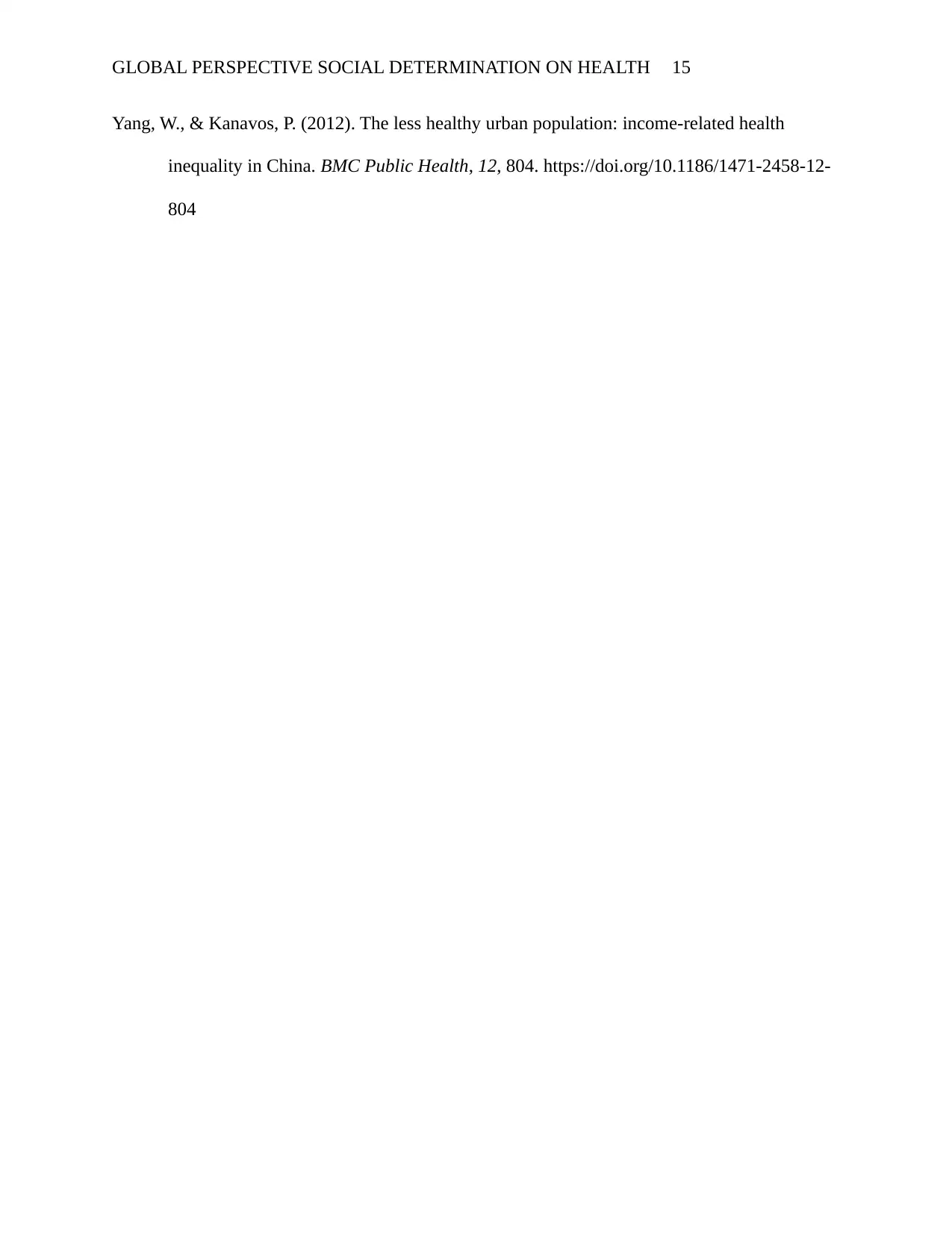
GLOBAL PERSPECTIVE SOCIAL DETERMINATION ON HEALTH 15
Yang, W., & Kanavos, P. (2012). The less healthy urban population: income-related health
inequality in China. BMC Public Health, 12, 804. https://doi.org/10.1186/1471-2458-12-
804
Yang, W., & Kanavos, P. (2012). The less healthy urban population: income-related health
inequality in China. BMC Public Health, 12, 804. https://doi.org/10.1186/1471-2458-12-
804
1 out of 16
Related Documents
Your All-in-One AI-Powered Toolkit for Academic Success.
+13062052269
info@desklib.com
Available 24*7 on WhatsApp / Email
![[object Object]](/_next/static/media/star-bottom.7253800d.svg)
Unlock your academic potential
© 2024 | Zucol Services PVT LTD | All rights reserved.





